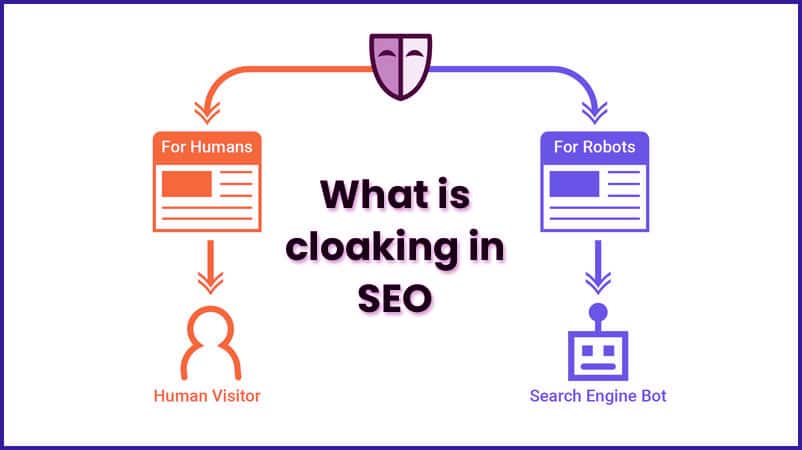What is Website Cloaking?
Before we talk about how cloaking works, first we need to know what is website cloaking. Cloaking in SEO/PPC is a black hat technique where a website presents a different URL or content to users and another one to search crawlers (i.e. spiders or bots) to improve a website’s search engine rankings for certain keywords.

What are the different types of cloaking and how is it works
- User-Agent cloaking
- IP based cloaking
- JavaScript cloaking
- HTTP_REFERER cloaking
- HTTP Accept-language header cloaking
- Iframe based cloaking
1. User-Agent Cloaking
In computing, a user agent is any software, acting on behalf of a user, which “retrieves, renders and facilitates end-user interaction with Web content. A user agent is therefore a special kind of software agent. When a browser requests a website/URL it generates a User-Agent string to identify the server about the request.
In website cloaking these user agents are tricked to provide different URL’s/Content to the actual user vs bots.
2. IP-based cloaking
IP cloaking, simply put, is when a person hides their IP address. Since anything a person does online is linked to their IP address, the main benefit of IP cloaking, is people want to avoid being tracked and monitored. This is achieved by accessing the internet through a second computer called a proxy server. The proxy server acts as an internet gateway while their IP address remains hidden.
3. JavaScript cloaking
This happens when users with Javascript enabled browsers are served one version of the content while users who have JavaScript disabled (like search engines) are served another version of a website.
4. HTTP_REFERER cloaking
HTTP_REFERER is a string constructed by the browser to show the resource from where user click landed on your page. In this method, scripts are used to define content for headers.
5. HTTP Accept-language header cloaking
Similarly, HTTP_REFERER header scripts can manipulate content based on the language header generated by the browser header string.
6. Iframe based cloaking
This technique is the oldest one. Nowadays it is easily caught by spiders and makes your URL spammy. In this method, the iframe is used to generate content on the URL, and based on settings it regenerates content for bots.
Benefits of cloaking
Cloaking can benefit you in many ways if used correctly and ethically
- Better user experience: You can gain your customer satisfaction, by showing the right content to the right audience.
- Better conversion rate: By targeting the right audience, you can increase your sales and leads.
- Ad Campaign Optimization: You can make your campaign better by keeping your ad account safe and secure on ad platforms.
Risks of Cloaking and Google Penalties
Although cloaking offers many benefits, search engines like Google consider it a black hat SEO technique if done incorrectly.
- Google penalty: Google can De-rank or lower down the search rankings of a website, if it finds that the website is using cloaking.
- Trust Loss: If a user is getting a different content from what is shown, it can have a bad impact on the brand.
- Account Suspension: If you use cloaking in Google Ads or Facebook Ads and don’t manage it correctly, Google or Facebook may Suspend your ad account.
The right cloaking solution for your Business
If you want to keep your Ad campaign safe and use Cloaking in a smart way, then you will need a professional cloaking service.
An advanced cloaking solution helps you to get the best result by keeping Ad campaigns safe & secure. It allows you to:
- Avoid search engine penalties
- Keeps Google Ads and Facebook Ads accounts safe
- Helps in getting better ROI (Return on Investment)
Best Part of Trafficshield.io
The best part of trafficshield.io cloaking is that it is not depending on only one factor. Trafficshield uses multiple conditions to determine whether the click came from the actual user or is it non-human generated.
We highly suggest to use Trafficshield.io cloaker to protect your URL’s and traffic.
Cloaking is a powerful SEO and digital marketing technique, which can make your advertising performance much better if you use it correctly. However if it is done in a wrong way, it can result in a google penalty. So always use a trusted and professional cloaking solution.
